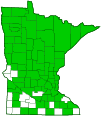swamp thistle
(Cirsium muticum)
Conservation • Wetland • Description • Habitat • Ecology • Use • Distribution • Taxonomy
Description |
||
Swamp thistle is a 12″ to 90″ tall, erect, biennial forb that rises from fibrous roots and a cluster of fleshy, stout, white to brown roots, rarely from a single taproot. The first year it appears as a rosette of basal leaves. The second year it sends up a single flowering stem. Basal leaves are egg-shaped to broadly elliptic or inversely egg-shaped in outline. They can be 6″ to 21½″ long, and 1½″ to 8″ wide, though they are usually no more than 12″ long and 4″ wide. They are on spiny-winged leaf stalks. The leaf blade is tapered at the base and deeply lobed (pinnatifid), the lobes cut ⅞ of the way to the midrib. The lobes are linear to lance-shaped and are sometimes lobed again. They taper to a point at the tip with straight or concave sides along the tip. The upper surface is green and nearly hairless or sparsely covered with short, curled hairs. The lower surface is green and nearly hairless or sparsely covered with long, soft, cobwebby hairs. The margins have a few irregular teeth and many fine, soft spines, the main ones 1 ⁄16″ to ⅛″ long. Basal leaves are usually absent at flowering time. The stem is erect, light green, ridged, and round in cross section. It has a few to many ascending branches, mostly above the middle. It may be hairless or sparsely covered with long, soft, spreading hairs, especially near the base. It is not winged and is not covered with a whitish, waxy substance (glaucous). Stem leaves are alternate and 1¼″ to 6″ long. The leaf blade is pinnatifid, the lobes relatively narrow and cut more than ½ of the way to the midrib. It is otherwise similar to basal leaves. Lower stem leaves are stalked. Stem leaves become smaller and shorter stalked but no less divided as they ascend from the middle of the stem toward the inflorescence. Upper stem leaves are stalkless, well developed, and often slightly clasp the stem at the base. The inflorescence is a single flower head or a more or less open, branched, cluster (corymb) of 2 to 5 flower heads at the end of each branch. The flower heads are stalkless or are borne singly on up to 6″ long stalks (peduncles). At the base of each peduncle there is a single 1″ to 3″ long, leaf-like bract. The corymbs are sometimes overtopped by the uppermost leaves. The flower heads are not subtended by a ring of spiny, leaf-like bracts. The whorl of bracts at the base of the flower head (involucre) is broadly cylinder-shaped or bell-shaped, ⅝″ to 1¼″ long, and ⅜″ to 1¼″ wide. It is often somewhat cobwebby hairy. The bracts of the involucre (phyllaries) are in 8 to 12 series. They are green with a dark green central (dorsal) patch surrounding a white, gummy, sticky ridge. The outer (lower) and middle phyllaries are egg-shaped and taper to a appressed or ascending, sharply or bluntly pointed tip. The inner phyllaries are linear. The phyllaries are tipped with minute, insignificant spines. They appear spineless except under close examination. The flower heads are to 1¼″ to 2″ in diameter and have numerous tubular disk flowers. The disk flowers are ⅝″ to 1¼″ long and reddish-purple or dark purple, rarely white The fruit is a dark brown, ⅛″ to 3 ⁄16″ long seed capsule (cypsela). The cypsela has a conspicuous yellow collar near the tip and a tuft of white or slightly grayish-tinged hairs at the tip. |
||
Height |
||
12″ to 90″ |
||
Flower Color |
||
Purple to pink |
||
Similar Species |
||
|
||
Habitat |
||
Wet. Meadows, prairies, marshes, swamps, bogs, woodland openings, streambanks. Full sun. |
||
Ecology |
||
Flowering |
||
July to October |
||
Pests and Diseases |
||
|
||
Use |
||
|
||
Distribution |
||||
|
Sources |
|||
| 6/27/2023 | ||||
Nativity |
||||
Native |
||||
Occurrence |
||||
Common |
||||
Taxonomy |
|||
| Kingdom | Plantae (Plants) | ||
| Division | Tracheophyta (Vascular Plants) | ||
| Subdivision | Spermatophytina (Seed Plants) | ||
| Class | Magnoliopsida (Dicots) | ||
Order |
Asterales (Sunflowers, Bellflowers, Fanflowers, and Allies) | ||
Family |
Asteraceae (Sunflowers, Daisies, Asters, and Allies) | ||
| Subfamily | Carduoideae (thistles and allies) | ||
| Tribe | Cardueae | ||
| Subtribe | Carduinae (thistles and burdocks) | ||
| Genus | Cirsium (plume thistles) | ||
Cardueae is a synonym of the tribe name. Cynareae was published first and has precedence. Nevertheless, most sources use the name Cardueae for the tribe. |
|||
Subordinate Taxa |
|||
|
|||
Synonyms |
|||
Carduus muticus Cirsium bigelovii Cirsium muticum var. monticola Cirsium muticum var. subpinnatifidum |
|||
Common Names |
|||
dunce-nettle horsetops swamp thistle thistle |
|||
Glossary
Bract
Modified leaf at the base of a flower stalk, flower cluster, or inflorescence.
Corymb
A flat-topped or convex inflorescence in which the stalked flowers grow upward from various points on the main stem to approximately the same horizontal plane. The outer flowers open first.
Cypsela
A dry, one-chambered, single-seeded fruit, formed from a single carpel, with the seed attached to the membranous outer layer (wall) only by the seed stalk; the wall, formed from the wall of the inferior ovary and also from other tissues derived from the receptacle or hypanthium, does not split open at maturity, but relies on decay or predation to release the contents.
Glaucous
Pale green or bluish gray due to a whitish, powdery or waxy film, as on a plum or a grape.
Involucre
A whorl of bracts beneath or surrounding a flower, flower head, or flower cluster.
Linear
Long, straight, and narrow, with more or less parallel sides, like a blade of grass.
Peduncle
In angiosperms, the stalk of a single flower or a flower cluster; in club mosses, the stalk of a strobilus or a group of strobili.
Phyllary
An individual bract within the involucre of a plant in the Asteraceae family.
Pinnatifid
Deeply cut, more than half way to the midrib but not to the midrib, into lobes that are spaced out along the midrib; the lobes do not form separate leaflets.
Wing
A thin, flat, membranous, usually transparent appendage on the margin of a structure.
The Native Thistle Test
Thistles native to Minnesota do not have spiny stems. Grasp the stem near the base of any native thistle loosely in your fist, then slide your fist upwards to just below the inflorescence. If the plant is a native thistle, you will not get a single prickle – it will be “ouchless”.
If the thistle in question is thought to be an exotic (non-native) species, this test is not recommended.
Swamp thistle is native.
Visitor Photos |
|||||
Share your photo of this plant. |
|||||
| This button not working for you? Simply email us at info@MinnesotaSeasons.com. Attach one or more photos and, if you like, a caption. |
|||||
|
|||||
MinnesotaSeasons.com Photos |
|||||
Plant |
|||||
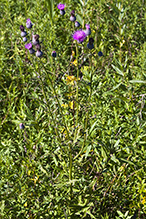 |
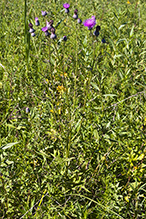 |
||||
Inflorescence |
|||||
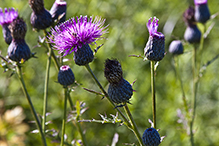 |
|||||
Corolla |
|||||
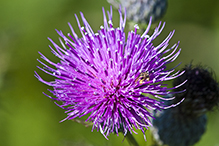 |
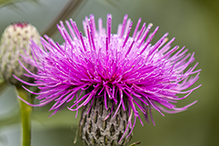 |
||||
Involucre |
|||||
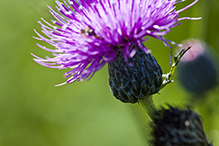 |
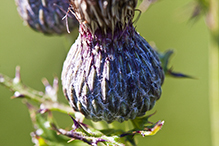 |
||||
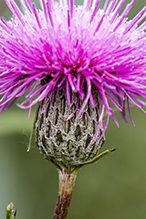 |
|||||
Leaves |
|||||
 |
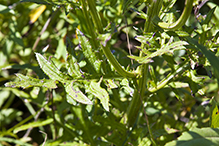 |
||||

Slideshows |
||

Visitor Videos |
|||
Share your video of this plant. |
|||
| This button not working for you? Simply email us at info@MinnesotaSeasons.com. Attach a video, a YouTube link, or a cloud storage link. |
|||
Other Videos |
|||

Visitor Sightings |
|||||
Report a sighting of this plant. |
|||||
| This button not working for you? Simply email us at info@MinnesotaSeasons.com. Be sure to include a location. |
|||||
|
|||||
MinnesotaSeasons.com Sightings |
|||||

|
Created: Last Updated: © MinnesotaSeasons.com. All rights reserved. |
